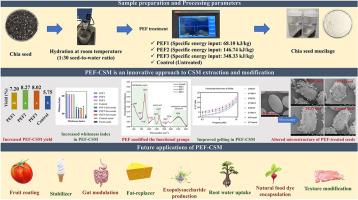Non-thermal extraction and modification of chia seed mucilage using Pulsed electric field
IF 11
1区 农林科学
Q1 CHEMISTRY, APPLIED
引用次数: 0
Abstract
This research investigates a non-thermal, chemical-free method for extracting and modifying chia seed mucilage (CSM) using Pulsed Electric Field (PEF) technology. The impact of different specific energy inputs - low (PEF1), medium (PEF2), and high (PEF3) on the yield, physical, functional, structural (FTIR), thermal (DSC), and microstructural (SEM) properties of CSM was investigated. PEF treatment significantly (p < 0.05) increased mucilage yields: PEF2 (8.27 ± 0.83 %), PEF3 (8.02 ± 0.26 %), and PEF1 (7.20 ± 0.17 %) compared to the untreated control CSM (5.75 ± 1.46 %). Higher energy input (PEF3) altered proximate composition, colour, true density, and functional properties such as water holding capacity (WHC) and oil holding capacity (OHC). Low and medium PEF enhanced the colour profile of CSM. However, PEF1 exhibited significantly (p < 0.05) higher storage (G′) and loss (G′′) moduli than PEF3. Solubility and zeta potential were found to be dependent on the pH of the medium. Modification of CSM through PEF was also revealed from the changes observed in the structural, thermal, and microstructural properties. PEF can be a sustainable, chemical-free approach for the mucilage extraction and modification, supporting the development of plant-based food nutrient-dense ingredients.

脉冲电场对奇亚籽浆液的非热提取和改性
研究了一种利用脉冲电场(PEF)技术对奇亚籽粘液(CSM)进行非热、无化学物质提取和改性的方法。研究了不同比能输入-低(PEF1)、中(PEF2)和高(PEF3)对CSM收率、物理、功能、结构(FTIR)、热(DSC)和微观结构(SEM)性能的影响。PEF处理显著(p < 0.05)增加了粘液产量:PEF2(8.27±0.83%),PEF3(8.02±0.26%)和PEF1(7.20±0.17%),而未处理的对照CSM(5.75±1.46%)。更高的能量输入(PEF3)改变了近似的成分、颜色、真密度和功能特性,如持水能力(WHC)和持油能力(OHC)。低PEF和中等PEF增强了CSM的颜色轮廓。然而,PEF1的存储(G’)和损耗(G’)模量显著高于PEF3 (p < 0.05)。发现溶解度和zeta电位与培养基的pH值有关。从结构、热性能和显微组织性能的变化也揭示了经PEF改性的CSM。PEF可以是一种可持续的、无化学物质的粘液提取和改性方法,支持植物性食品营养密集成分的开发。
本文章由计算机程序翻译,如有差异,请以英文原文为准。
求助全文
约1分钟内获得全文
求助全文
来源期刊

Food Hydrocolloids
工程技术-食品科技
CiteScore
19.90
自引率
14.00%
发文量
871
审稿时长
37 days
期刊介绍:
Food Hydrocolloids publishes original and innovative research focused on the characterization, functional properties, and applications of hydrocolloid materials used in food products. These hydrocolloids, defined as polysaccharides and proteins of commercial importance, are added to control aspects such as texture, stability, rheology, and sensory properties. The research's primary emphasis should be on the hydrocolloids themselves, with thorough descriptions of their source, nature, and physicochemical characteristics. Manuscripts are expected to clearly outline specific aims and objectives, include a fundamental discussion of research findings at the molecular level, and address the significance of the results. Studies on hydrocolloids in complex formulations should concentrate on their overall properties and mechanisms of action, while simple formulation development studies may not be considered for publication.
The main areas of interest are:
-Chemical and physicochemical characterisation
Thermal properties including glass transitions and conformational changes-
Rheological properties including viscosity, viscoelastic properties and gelation behaviour-
The influence on organoleptic properties-
Interfacial properties including stabilisation of dispersions, emulsions and foams-
Film forming properties with application to edible films and active packaging-
Encapsulation and controlled release of active compounds-
The influence on health including their role as dietary fibre-
Manipulation of hydrocolloid structure and functionality through chemical, biochemical and physical processes-
New hydrocolloids and hydrocolloid sources of commercial potential.
The Journal also publishes Review articles that provide an overview of the latest developments in topics of specific interest to researchers in this field of activity.
 求助内容:
求助内容: 应助结果提醒方式:
应助结果提醒方式:


